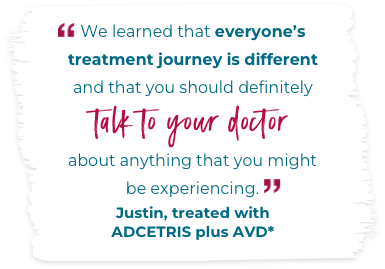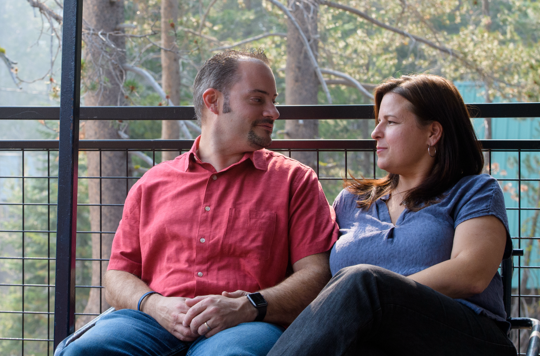Preparing for treatment with ADCETRIS
Working with your healthcare team and learning
what to expect from treatment can
help you feel
more confident in
making your treatment decision.


*Justin was compensated by Pfizer for participating in this campaign.

Before starting treatment, tell your doctor about the following:
- All of your medical conditions
- Current medications, including supplements and vitamins to avoid drug interactions
- If you are pregnant or plan to become pregnant, because
ADCETRIS treatment may harm your unborn baby
- Female patients who are able to become pregnant should use effective birth control during treatment and for 2 months after their last ADCETRIS dose
- Male patients with female partners who can become pregnant should use effective birth control during treatment and for 4 months after their last ADCETRIS dose
- If you are breastfeeding
- Don't breastfeed during treatment due to the risk to the baby
Use the questions in the Doctor Discussion Guide to get started talking about ADCETRIS treatment with your doctor.
How ADCETRIS is given
-
Previously untreated classical Hodgkin lymphoma
-
ADCETRIS is given with chemotherapy (AVD) as an intravenous (IV) infusion (directly into the vein), at the doctor’s office or clinic.
-
The infusion is given every 2 weeks with chemotherapy for approximately 6 months (12 treatments) until your disease progresses or you have unacceptable side effects.
-
The ADCETRIS infusion takes about 30 minutes. Additional time is needed for AVD chemotherapy infusions. Your doctor may ask you to come to the office early to prepare and stay afterward for monitoring. Your doctor may reduce, hold, or stop your ADCETRIS treatment based on side effects.
-
-
Relapsed classical Hodgkin lymphoma
-
ADCETRIS is given as an intravenous (IV) infusion (directly into the vein), at the doctor’s office or clinic.
-
The infusion is given every 3 weeks until your disease progresses or if you have unacceptable side effects.
-
The ADCETRIS infusion takes about 30 minutes. Additional time is needed for AVD chemotherapy infusions. Your doctor may ask you to come to the office early to prepare and stay afterward for monitoring. Your doctor may reduce, hold, or stop your ADCETRIS treatment based on side effects.
-
-
After stem cell transplant
-
ADCETRIS treatment begins 4 to 6 weeks after your stem cell transplant or when your doctor decides you are ready. It will be given as an intravenous (IV) infusion (directly into the vein) at the referring doctor's office or transplant center.
-
Once you are at home, ADCETRIS may continue at the doctor’s office or at an
outpatient clinic. -
The infusion is given every 3 weeks for up to 16 doses. You may get fewer than 16 doses if your disease gets worse or if you have unacceptable side effects.
-
The infusion takes about 30 minutes. Your doctor may ask you to come to the office early to prepare and stay afterward for monitoring. Your doctor may reduce, hold, or stop your ADCETRIS treatment based on side effects.
-
Glossary
AVD: A combination of 3 chemotherapies—Adriamycin, vinblastine, and dacarbazine.
Relapse: When cancer has returned after a period of remission.

Why it’s important to tell your doctor how you’re feeling
During treatment with ADCETRIS, patients may experience certain side effects. It is important to tell your doctor as soon as possible about any symptoms that develop. Your doctor may need to make adjustments to your treatment plan, delay administration of the next dose, or give a smaller dose of ADCETRIS until symptoms improve. In cases where side effects are severe, or do not improve, ADCETRIS may need to be stopped completely.
Justin’s treatment journey
justinIt all started with a cough. After multiple visits to the doctor and too many tests to count, Justin was eventually diagnosed with Stage 4 Hodgkin lymphoma. Helping him navigate his diagnosis was his wife, Crystal. She was his advocate, caregiver, and support system throughout the treatment process.
ADCETRIS will not work for everyone.
